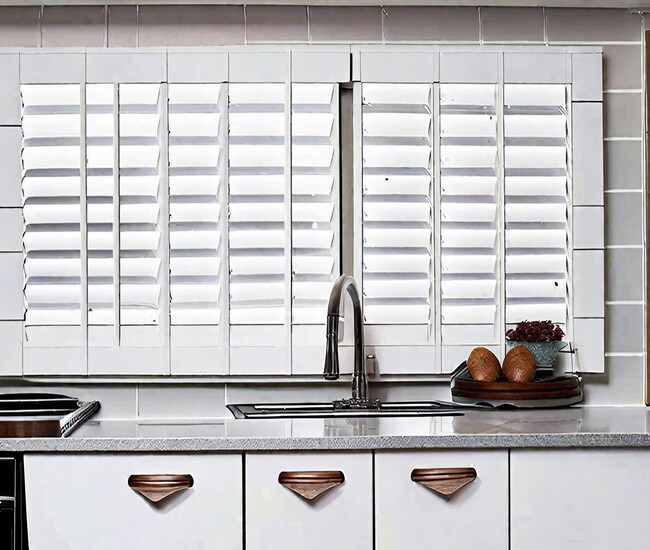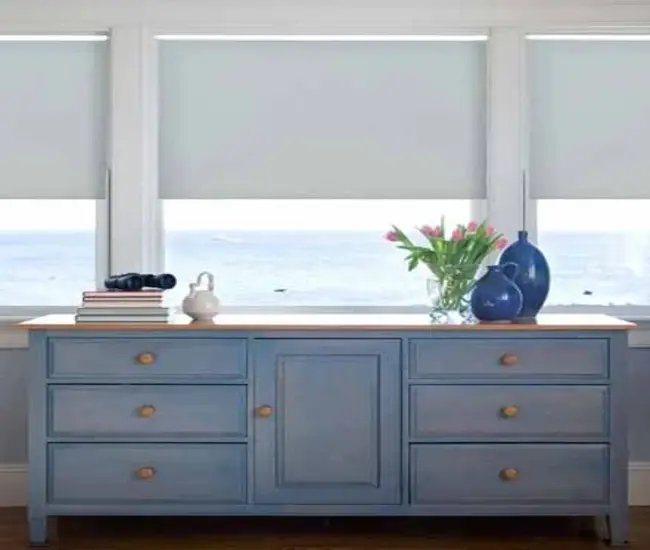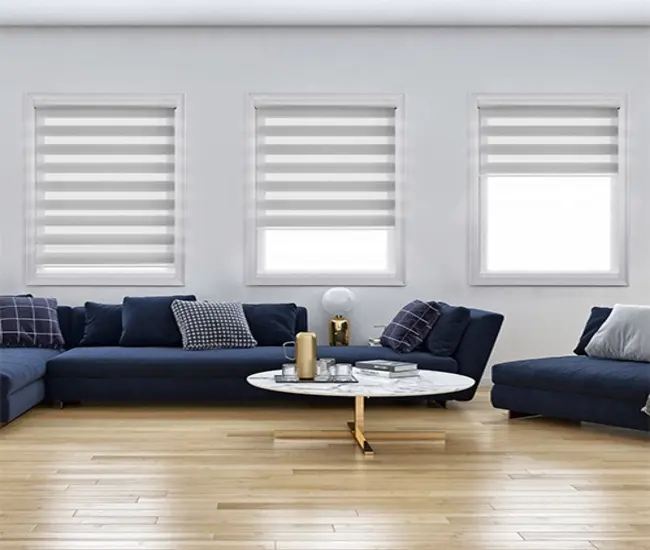Looking for the best window treatments for the dining room in the right color, size, style, look, and material? Check out our comprehensive guide for choosing window blinds, shades, shutters, and drapes for dining rooms, along with 5 best expert-backed picks!
Dining room window treatments, blinds, shades, curtains, and drapes let in pleasant, diffused light and luxurious formal or casual dining ambience. Fabric shades and romans will add a decorative touch. Light filtering fabrics will flood the dining area with lots of softly filtered light, while maintaining a private and glare-free environment.
Shop from our curated selection of dining room blinds and shades and get free samples, free shipping, free expert advice. These practical dining room window treatment ideas will help you navigate finding the perfect style, size, look, function, and material depending on the style of your eating area.
These standout ideas to cover your dining room windows will help elevate your decor and create a cozy ambiance.
Your dining room needs a window treatment, such as a practical sheer shade or an elegant wood shutter, that can add to its interior décor and functionality. It should also be easy to install, operate, and maintain. Here is a comprehensive guide to the 5 best window treatments for dining rooms.
5 Best Window Treatments for Dining Rooms

The 5 best window treatments for a dining room include draperies, shades, blinds, balloon valances, and plantation shutters. Each can be customized for size, style, color, design, functional potential, lift options, and affordability. Also, they are available with huge discounts, free samples, free DIY installation tips, and a free lifetime warranty.
1. Draperies to Add Softness, Texture, & Color
Among the 5 best window treatments for a dining room, draperies are a more popular choice.
Here are some of the reasons to choose draperies for dining rooms:
Pros
- Adding Softness and Texture: Drapery is chosen for the dining room because of its softness and its ability to add texture and color to your dining room’s interior décor style.
- Formal and Casual Styles: Draperies for dining room window treatments can be either formal or casual depending on the material and style.
- Layering: You can layer a fabric shade or wooden blinds over the drapery to create a casual look. You can also combine several different window treatments for your dining room.
Cons
- Draperies require ironing after washing to maintain their shape.
- Can be expensive in many cases.
2. Practical Sheer Shades for Softly Filtered Light and Privacy

Here are some of the reasons to choose shades for your dining rooms.
- Light Filtering Functionality: You can also choose a fabric for your dining room shades that will softly filter and diffuse light coming in through the windows.
- Cleaner Look: If you have a tall window in your dining room, you can choose a roller shade that will hide the mechanism and give a cleaner look. You can also choose one that matches the color and style of the rest of your room. Pink is always a good choice.
- Sophisticated, Personalized Appearance: You can combine a well-designed shade with a drape to get a sophisticated, personalized look in your dining room.
- A Wide Range of Price Points: These window treatments come in a range of prices. There are budget-friendly options as well as more classic, timeless styles.
- Kid-Safe Cordless Lift: A common choice among homeowners is a cordless lift shade. It is easy to use and eliminates unsightly wires.
- Motorized Lift: Motorized shades are ideal for large windows. These window treatments are easy to use and great for homes with pets and children. A shade can make your dining room look great at a price you can afford.
Cons
- Shades may not offer the same level of ventilation and airflow as blinds.
- Might require occasional professional cleaning.
3. Horizontal Blinds – Affordable Option to Add Timeless Elegance and Extra Personality to Dining Room
Horizontal blinds for dining rooms are characterized by horizontal slats.
Pros
Versatile Function: The slats can be raised, lowered, or tilted for the required amount of light control, privacy, insulation, and other benefits.
Lots of Design Variants: Horizontal blinds are available in different functional and design variants, such as privacy wood blinds, light filtering blinds, faux wood blinds, cordless blinds, mini blinds, and motorized blinds. Among them, privacy wood blinds are usually preferred over other variants.
Cons
- Blinds may not fit all types of dining room windows and doors.
- Take longer to clean.
4. Balloon Valances with Floral Motif – Perfect for Dining Rooms

A balloon valance is a great choice for a dining area.
Lightweight: Balloon valances are usually made of lightweight cotton and drape over the windows.
Classic, Opulent Profile: Balloon valances have a classic, opulent profile to beautify your dining room’s interior. They can also be made from satin or chiffon.
Cons
- May not offer complete blackout
- Not suitable for full privacy
5. Faux-wood Plantation Shutters

There are many reasons why homeowners choose faux-wood plantation shutters as one of the 5 best window treatments for dining room window treatments.
Here are the pros and cons of faux wood plantation shutters.
Pros
- Custom Fit: They can be custom fitted to fit any window shape, including arched windows and bay windows in your dining room. These shutters can be made from many different materials, and are available in many colors and finishes.
- Natural Wood Finish: These shutters are popular for dining room window treatments because of their natural wood finish. However, this does not mean you should compromise on quality. Faux-wood shutters are a great alternative to real hardwood, and they have a timeless appeal.
- Energy-Efficiency: Faux-wood plantation shutters can also be very energy efficient. They reduce heat loss through windows, making your home much more comfortable and keeping your thermostat from overworking. Weather-stripping allows these shutters to be adjusted easily. These shutters are ideal for a dining room. Once installed, faux-wood plantation shutters are easy to operate with a hidden tilt rod.
- Additional Accessories: These shutters for dining rooms can be purchased with additional accessories, such as a sidelight, to match the decor.
Cons
- Faux wood plantation shutters may not be the best option to cover large windows.
- Sagging can be a problem with faux wood plantation shutters.
Factors to Consider When Choosing the Best Window Treatment for Dining Rooms

Choosing the right window treatments for the style of your dining room can enhance its overall look and functionality. Here are some factors to consider when selecting best window coverings for your dining room:
Style of Dining Room Decor
Window treatments can add style, texture, and personality to your dining room. Consider the overall style and decor of the room when selecting window coverings. For a modern look, consider selecting roller or cellular blinds. For a classic look, go for wooden blinds or shutters.
Need for Softly Filtered Light in Eating Area
Depending on the style of your dining room, you may want to consider the amount of softly filtered natural light that enters the space. For example, if your dining room receives a lot of direct sunlight, consider light filtering honeycomb or sheer fabrics that also offer a high decorative appeal.
Privacy in Dining Space
If your dining room windows face a busy street, privacy may be your concern. Window treatments such as vertical or horizontal blinds can be adjusted to provide privacy while still allowing some natural light to enter the dining room.
Maintenance Requirements for Dining Room Window Treatments

Some window treatments require more maintenance than others. For example, wooden blinds may require regular dusting and occasional vacuuming. If you prefer low-maintenance blinds, consider selecting aluminum or vinyl blinds.
Budget

Window treatments for dining rooms come in a wide range of price ranges, from as low as $25 to over $1000. Consider your budget when selecting window coverings for your dining room. While some styles may be more expensive than others, it’s important to select quality shades or blinds that will last for many years.
Cost
By considering these important factors, you can choose window blinds that meet your needs and enhance the look and feel of your dining room’s interior.
Different Styles of Shades for Dining Rooms
Shades for dining rooms are available in different styles, including roller, sheer, and tie-up. In a room where guests are expected to visit, it is important to choose the right shade.
Roller Shades to Add Sleeker Look to Dining Room Windows

When choosing the window treatment for your dining room, look for roller shades that will help you achieve the desired aesthetic. They are a great choice for privacy but often lack style. However, there are many styles of roller shades available today.
Premium Woven Wood Fabric Roller Shades
High quality woven wood fabric roller shades look like bamboo or wood and are lightened to a minimum. These shades can come in virtually any color, including white.
Sheer Shades

A combination of blinds and window coverings, light-filtering sheer shades can be used to block out the sun. These products filter light and cut down on UV rays while providing privacy. They also look great. This article will discuss the many benefits of window coverings.
Continue reading to learn how to choose the right style to decorate your dining room. Light-filtering sheer shades are an excellent choice for rooms with limited natural light. Because of their sheer appearance, these window treatments filter glare and soften spaces with high contrast. These shades can add a whimsical and delicate air to your home.
Tie-up Shades
If you are interested in decorating your dining room with custom window treatments, you may want to consider buying tie-up shades. These are essentially curtains with ties on the sides. For a personal look, you can add different fabric ties to the curtains. You can also buy them in many different styles and patterns if you don’t feel confident cutting linen. They can help create a more formal ambiance than blinds and drapery.
What are Different Types of Blinds for Dining Rooms?
Privacy Wood Blinds

While shades may offer privacy, they do not provide the same aesthetic appeal as privacy wood blinds.
Wood Blinds for Durability and Natural Beauty
Wooden blinds are elegant and natural looking in any dining area. These window treatments are made to look like real bamboo or wood. They reduce the sun’s glare and heat.
Faux Wood Blinds

Faux wood blinds can be a good choice for those who are worried about the cost. Wood blinds are a better option if you prefer the natural look and feel of woven bamboo or wood.
When choosing blinds for your dining rooms, consider where you will place these blinds. If the blinds are facing the street, you’ll need privacy. On the other hand, if the windows are located inside your house, you’ll want to keep them hidden from your neighbors. For privacy in these areas, you’ll want to opt for composite or faux wood blinds. These materials can withstand moisture better than real hardwood.
What are Different Styles of Balloon Valances for Dining Rooms?
Here are different variants of balloon valances for dining rooms.
Swag Valance for Dining Room Windows
A swag valance can be a beautiful choice for a dining area. These drapes are reminiscent of a traditional valance and can be made in a variety of colors and prints.
Pouf-Style Balloon Valance
A pouf-style balloon valance will give your dining room a whimsical look. These dining room window treatments can be paired with cafe curtains or blinds. You can also choose a balloon-style valance that is reminiscent of a ball. Either way, these valances are a fun way to personalize the space and express your personal style. There are many styles and colors of balloon valances available, so you can find the right one to fit your dining room.
Box-pleated Valance
Another popular style is the box-pleated valance. This style is very similar to a regular vale but is wider and gathers higher above the window frame. It is attached to the window frame with an L-shaped rod. This type looks best when paired with drapery panels. It will soften the window lines. If you’re unsure about which style to choose, make sure to find a fabric that complements your interior décor style.
FAQs
Are curtains or blinds better for dining rooms?
While curtains occupy more space, blinds, shades, and shutters are the most suitable window treatments for dining rooms. We highly recommend light filtering blinds for a dining room for letting in softly filtered light, while also reducing glare and maintaining privacy.
What kind of window treatments does Joanna Gaines use?
Joanna Gaines prefers neutral fabric window treatments with simple, long draperies that let in light, while maintaining privacy and softening the rustic elements incorporated into the decor. The light filtering fabrics help flood the dining room with soft, glare-free light.
Can you put blinds in the dining room?
Should you put blinds in a dining room? The answer is yes! When it comes to options for blinds, shades, curtains, and shutters in the dining room, blinds go pretty well both in terms of look and function. Based on your personal taste, you can also select side panels and draperies for your dining room windows.
What is the best window covering for a kitchen window?
Being moisture-resistant, durable, and easy to wipe down, faux wood blinds and faux wood shutters are the best window coverings for a kitchen window located near the food-prep area or above sink. Other practical options for kitchen window coverings include vinyl blinds, layered curtains and zebra shades, cellular blinds, roller and solar blinds, classic Roman shades, tailored Roman shades, and sheer shades.
What are the most fashionable window blinds?
Allusion blinds are the most fashionable window blinds and the fastest growing trend in window treatment, as they are incredibly versatile, providing privacy, light control, and soft, subtle look. If you are looking to bring a stylish yet traditional look to any room, Venetian blinds are one of the most popular styles of window blinds to consider.
What are the best blinds to keep heat and light out?
Blackout blinds made from insulating honeycomb fabric are the best blinds to keep heat and light out of your dining room, kitchen, and other spaces. They keep solar rays at bay, helping with light control and temperature regulation.
Need More Help?
Still unsure about the best window treatment for your dining room? Get in touch for free consultation! Use 24/7 live chat or give us a call at (800) 863-6109 to contact our experts for DIY dining room window treatment solutions.
Measuring Guide for Window Treatments for Dining Rooms
